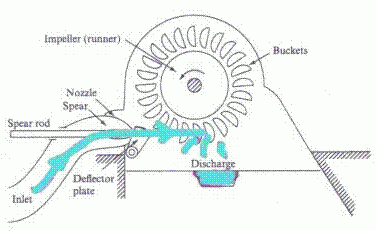
Microhydro Overview
Our plans and research for our microhydro system.
Our overall goal is to implement a cheap, efficient microhydro system in rural communities in the Philippines. The essential components of such a system are minimal: a turbine, a generator, and some way to redirect water from a river or stream.
How It Works
Microhydro doesn't use dams to generate power, but rather the natural flow of water in streams and rivers. Pipes redirect a portion of a river or stream towards a turbine, turning the turbine and converting the kinetic energy of the water into electrical energy in a generator. There's no dam involved, so this method of hydroelectric generation is much more environmentally friendly than bigger projects that completely block portions of a river or stream.
(image from https://www.researchgate.net/figure/Equation-model-of-micro-hydro-turbine_fig1_274561116)

Types of Turbines
One of the most important aspects of a microhydro system is the turbine that generates electricity from moving water. We've identified a few different types of turbines we could use, depending on the size and scale of our system.
Pelton Wheel
The Pelton wheel uses the concept of jet force to create energy. Water is funneled into a pressurized pipeline with a narrow nozzle at one end. The water sprays out of the nozzle in a jet, striking the double-cupped buckets attached to the wheel. The impact of the jet spray on the curved buckets creates a force that rotates the wheel at high efficiency rates of 70–90%. Pelton wheel turbines are available in various sizes and operate best under low-flow and high-head conditions.
(image from https://www.renewablesfirst.co.uk/hydropower/hydropower-learning-centre/pelton-and-turgo-turbines/)


Turgo Wheel
The Turgo impulse wheel is an upgraded version of the Pelton wheel. It uses the same jet spray concept, but the Turgo jet, which is half the size of the Pelton, is angled so that the spray hits three buckets at once. As a result, the Turgo wheel moves twice as fast. It's also less bulky, needs few or no gears, and has a good reputation for trouble-free operations. The Turgo can operate under low-flow conditions but requires a medium or high head.
(image from http://www.alternative-energy-tutorials.com/energy-articles/turgo-turbine-design.html)

Jack Rabbit
The Jack Rabbit is a drop-in-the-creek turbine that can generate power from a stream with as little as 13 inches of water and no head. Output from the Jack Rabbit is a maximum of 100 Watts, so daily output averages 1.5–2.4 kilowatt-hours, depending on your site.
(image from http://nooutage.com/images/aquair1.jpg)

Propeller Turbine
A Propeller Turbine consists of three to six usually fixed blades set at different angles aligned on the runner. The bulb, tubular, and Kaplan tubular are variations of the propeller turbine. The Kaplan turbine, which is a highly adaptable propeller system, can be used for microhydro sites.
(image from https://www.mechanicalbooster.com/2018/02/kaplan-turbine.html)